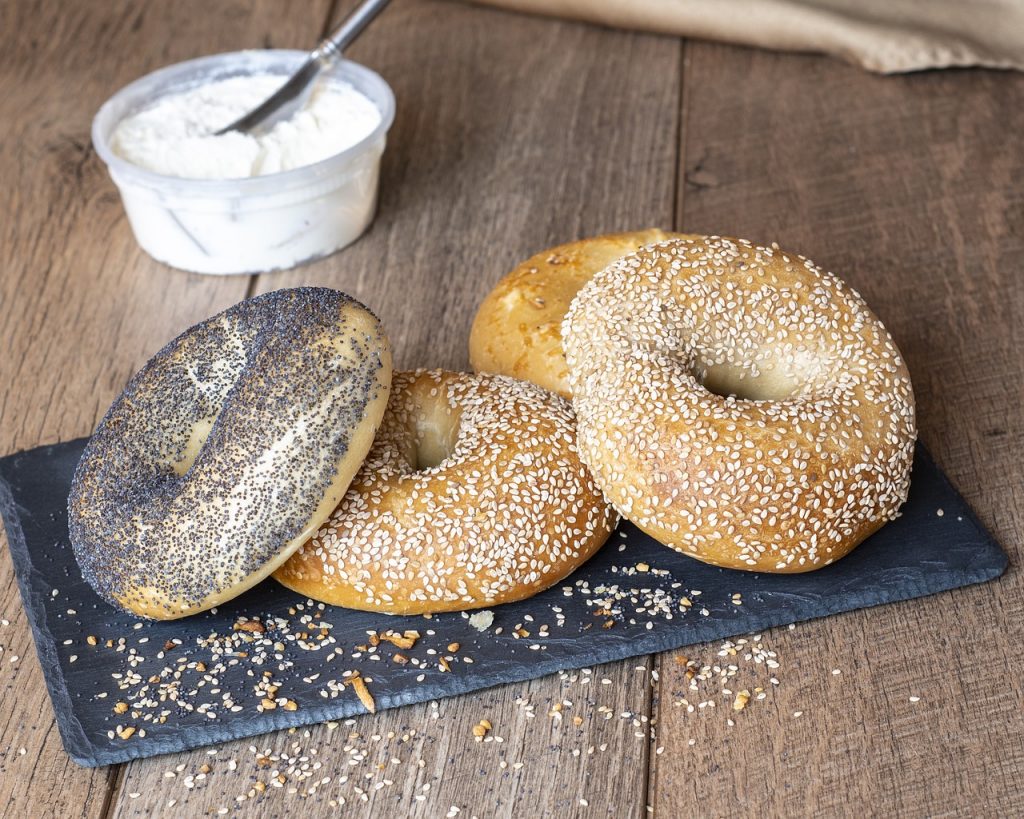The History Of Bagels In The United States
Learn about the history of bagels and discover why we love them in the United States.
This article is more than 2 years old

Bagels are a big part of American breakfast culture. We enjoy our bagels schmeared with cream cheese and piled high with lox. We gobble up bagels stuffed with bacon (pork roll if you happen to reside in New York City or New Jersey), egg, and cheese. And some of us even prefer to devour the bread-like beauties slathered with some butter. A Bagel is a simple food that pairs well with almost any topping you can imagine. The best part is that their simplicity is what makes them so irrevocably delicious. In fact, in the United States, we think they are so delicious that we eat a collective 202 million bagels every year. It’s clear that the US has a thing for bagels. Hence, we decided to delve into the history of bagels to discover how we came to develop such an affinity for the deliciously round delectable dough.
BAGEL BEGINNINGS

While it remains uncertain as to the exact inspiration that gave way to the emergence of the modern bagel, there are a couple of theories as to what it might have spawned from. The history of bagels likely dates all the way back to the late 1300s. During that time the Polish frequently made bread called Obwarzanek. Although the taste and texture of the Obwarzanek differed from that of a modern bagel, it resembled how bagels look today because it was shaped in a round circle with a large hole in the center.
Other theories suggest that the bagel may have been inspired by the German pretzel. The thought is that Poland’s Jewish population developed the bagel as a longer-lasting variation of the pretzel. Extending the lifespan of the bread was highly valued in poorer populations who looked for ways to make their resources last longer.
ASHKENAZI ANCESTRY

Even though the earliest accounts in the history of bagels remain somewhat hazy, the credit for the creation of bagels as we know them today goes to the 17th Century Ashkenazi Jews in Poland. A historical account of medieval Krakow, Poland revealed that in 1610 a law passed that forbid the Jewish population from baking. The ruler at the time dictated that baked goods should only be reserved for noble Christians. In response to the law, the savvy Ashkenazi developed a technique of boiling the bread. This technique is what birthed the very first Jewish bagel.
Eventually, the law was forgotten and Jewish bagel makers began to bake the dough, however, they kept the boiling technique in order to ensure that the bagels retained their unique flavor and texture. In the decades following, in recounting the history of bagels, many Jewish bakers were able to make a livable wage off of their delicious dough products. Primarily because Poland was a rich epicenter for wheat which served to make crafting bagels an advantageous career choice for the time.
COMING TO AMERICA

Similar to pizza, bagels got their start in the United States on the cobblestone streets of late 19th century New York City. In the late 1800s and early 1900s, large populations of Jewish immigrants from Poland were arriving at the southern shores of Manhattan. And, similar to how Italian immigrants bought their cultures and cuisines across the seas with them, as too did the Polish Jews.
Early on after their arrival, the Eastern European immigrants settled in Manhattan’s lower east side. The Polish bagel makers quickly started to sell their bagels as street foods off of carts that they would place in their neighborhoods. Creatively, these bagel vendors would use the hole in the center of the bagel and hang up the freshly baked goods on a rope hung from their cart so that a passerby could simply grab the bagel of their choosing, pay, and be on their way. Ironically, this is still a common practice in New York City today. Even though bagels are no longer hung from strings, grabbing your bagel from a local street vendor is about as New York as it gets.
By 1915 the bagel industry in the Jewish communities situated on the Lower East side was booming. In just that relatively small area, between carts and brick and mortar bakeries, there were at least 100 businesses. Unfortunately, working conditions for many bagel bakers remained appallingly poor. To combat this the very first Bagel Workers Union was formed that same year.
The history of bagels in the United States doesn’t end there, however. While bagels certainly had a significant presence in the Jewish communities that had nestled themselves on the Lower East Side of Manhattan, they had yet to be fully adopted and enjoyed by the masses. It wasn’t until the 1970s that that began to change.
LEAVE IT TO THE LENDERS

The 1970s were a time when bagel consumption in America began to slowly tilt upwards. However, in examining the history of bagels in America, it really wasn’t until the 1980s that bagels would see an eruption in popularity. This was all thanks to a little family called the Lenders (you may have heard of them).
Harry Lender got his start making bagels in Passaic, New Jersey. He eventually took his skills and set up another establishment in New Haven, Connecticut which he named New York Bagel Bakery. Lender came to operate the first successful bagel shop to exist outside of New York or New Jersey. His establishment remained locally successful until a frozen bagel incident provided the key that Lender needed to begin more widely distributing his beloved bagels to other establishments looking to sell them.
Harry Lender passed away in 1960, but his two youngest sons, Murray and Marvin, carried on the business in his stead. It was thanks to Murray and Marvin’s clever marketing tactics and use of the freezing technique that their father has accidentally stumbled upon a decade earlier that, in the history of bagels, catapulted the bagel to superstardom in the United States. By 1984 Lender’s frozen bagels were a household name and could be found in freezers across the nation.
That same year, in 1984, Lender’s was acquired by Kraft in what was the precursor that came to be known as the “marriage of the century.” A phrase that was also coined as a result of the Lender brothers’ marketing prowess. The phrase was so apt because Kraft owned Philadelphia Cream Cheese which made the acquisition of Lenders seem like a match made in heaven given that cream cheese was an ever-popular bagel topping choice. Thanks to the Lenders, bagels had finally truly made it in America.
BAGELS TODAY

The history of bagels led to their unwavering popularity in the Unites State at present. Today, you can order a bagel from a slew of different establishments from chains like Starbucks and Dunkin’ to local joints that forgo the frozen route. The widespread availability of bagels across the United States certainly serves its purpose. However, if you truly want to experience what a real bagel tastes like, you have to visit the parts of the United States where the bagel got its start. New York City is chock full of authentic options, as is New Jersey. You’ll thank us later!



